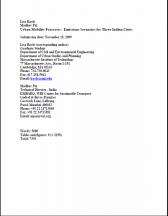
Madhav Pai & Lisa Rayle
The growth of motorization and travel activity associated with India’s rapid urban development has serious implications for global climate change. Effective mitigation action requires comprehension of the scale of the problem. Data limitations, however, have thus far constrained efforts to understand how changes in demographics, travel behavior, and policy might affect future emissions of greenhouse gases. This study uses recently available data on city-level travel patterns to forecast emissions from passenger transport for three metropolitan areas in India: Mumbai, Ahmedabad, and Surat. The forecasts compare carbon dioxide (CO2) emissions for three scenarios by using various mode choice and trip length assumptions. The results predict dramatic increases in emissions under all circumstances. Travel in Surat is forecast to generate between 1.9 and 9.5 million tons of CO2; in Mumbai, travel could generate 10.3 to 49 million tons. Differences, however, between scenarios suggest the potential positive effects of policy interventions. While the results help convey the magnitude of the emissions problem, further analysis requires more complete data on individual travel behavior.
If you have any questions or comments, or would like to know more about this research, contact Madhav Pai at madhav.pai@wri.org.
